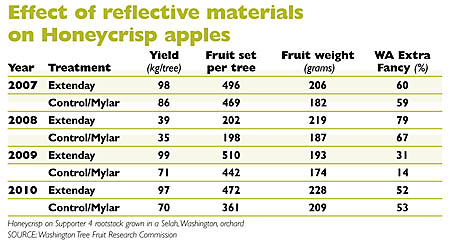To stay in business for the long haul, orchardists must produce exceptional quantities of exceptional fruit. Fortunately, there are many tools available to help growers reach target fruit goals, and increase profitability while decreasing costs, says Tory Schmidt, horticultural associate for the Washington Tree Fruit Research Commission. Schmidt highlighted the following areas for growers to focus on:
Crop load management—Growers should strategically prune to specific bud counts and prune to manage light penetration and interception. Pruning to a bud count is easier to do when orchards have uniform fruiting walls.
Bloom thinning—Effective products are available for chemical thinning, including lime sulfur and oil, a combination identified by the Research Commission as the best chemical thinner for Pacific Northwest orchards.
Postbloom thinning—Benzyladenine products like MaxCel are effective cleanup thinners, especially when applied to coincide with two to three days of warm weather (60° to 70°F). Schmidt believes BA is a must for Bartlett pears and smaller-sized fruit varieties like Gala, Jazz, and Pink Lady.
Smart hand thinning—Research by Pennsylvania State University has shown that the Equilifruit, a small plastic, notched disk developed by the National Institute for Agriculture Research in France, can help determine the optimum crop load of a given branch and guide workers in determining the number of fruit that should be left on the branch by workers. Using “rule of thumb” hand thinning guides often results in overthinning.
Reflective fabrics—Both Mylar and Extenday can improve grower returns. However, field trials conducted by the Research Commission have shown that Extenday, when used throughout the season, also increases yields and fruit weight as well as color and can increase fruit set, resulting in a higher proportion of target fruit (WA Extra Fancy grade). The research also showed that yield effects of season-long applications of Extenday were cumulative over time, with yields increasing by 12 percent in the first year, 26 percent in the second, and 23 percent in the third.
Two-dimensional fruiting walls—Two-dimension or planar fruiting walls, either vertical or V angled, have several advantages beyond their adaptability to mechanization. These systems have shown higher yields, better fruit color, improved production in the lower parts of the tree, better spray coverage, and more efficient and happier workers.

Orchard renovation tools
Schmidt said that growers have many tools available for renovating orchards and converting them to more efficient orchard systems. Soil fumigation has proven to be effective in controlling replant diseases. Improved genetics have led to development of rootstocks and varieties with pest and disease tolerance, such as the Geneva rootstock series developed at Cornell University.
Growers should also be installing drip irrigation systems in their renovated orchards to use water more efficiently and apply nutrients and crop chemicals through fertigation. Drip or buried drip irrigation can be an effective way for growers to implement deficit irrigation strategies to manage canopies and fruit maturity, Schmidt added.
Through strategic pruning and use of plant growth regulators, growers can achieve planar tree structures that are adapted to platforms, mechanized thinning, mechanized pruning and hedging, and harvesting and harvest-assist machines.

Leave A Comment